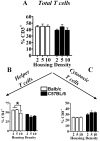Effects of housing density on weight gain, immune function, behavior, and plasma corticosterone concentrations in BALB/c and C57BL/6 mice
- PMID: 18351717
- PMCID: PMC2653995
Effects of housing density on weight gain, immune function, behavior, and plasma corticosterone concentrations in BALB/c and C57BL/6 mice
Abstract
The Guide for the Care and Use of Laboratory Animals contains recommended housing densities for rodent species that are commonly used by the scientific community. However, at the time of the Guide's publication, housing density recommendations were based heavily on the professional judgment of qualified scientists. Some scientists therefore question whether rodents can be housed at greater densities, whereas others wonder whether the space currently provided for rodents is sufficient. The present study was designed to determine the effect of housing adult female BALB/c- and C57BL/6-mice in standard 75-in(2) (484-cm(2)) ventilated cages at various housing densities (n = 2, 5, and 10 mice/cage). Measures of weight gain, plasma corticosterone, behavior, and immune parameters were evaluated at 7, 28, and 70 d after housing allocation. Housing BALB/c mice at 10/cage had negative effects on weight gain, corticosterone, behavior, and immune parameters. Housing C57BL/6 mice at 10/cage did not affect immune function or weight gain, although behavior and corticosterone showed statistical trends implying a negative effect Differences associated with housing densities of 2 and 5 mice/cage were less robust for all variables measured. We conclude that housing female BALB/c mice at 10 mice/cage (that is, at twice the Guide-recommended density) affects their physiology. We also conclude that mice vary in their responses in the parameters measured. These observations support the conclusion that it will be extremely challenging to scientifically determine an optimal cage density standard that can be uniformly applied across all mouse strains.
Figures







References
-
- Anisman H, Prakash P, Merali Z, Poulter MO. 2007. Corticotropin releasing hormone receptor alterations elicited by acute and chronic unpredictable stressor challenges in stressor-susceptible and -resilient strains of mice. Behav Brain Res 181:180–190 - PubMed
-
- Belzung C, Griebel G. 2001. Measuring normal and pathological anxiety-like behaviour in mice: a review. Behav Brain Res 125:141–149 - PubMed
-
- Canadian Council on Animal Care 1993. Guide to the care and use of experimental animals. Ottawa (Ontario): Bradda Printing Services
-
- Chapman JC, Christian JJ, Pawlikowski MA, Michael SD. 1998. Analysis of steroid hormone levels in female mice at high population density. Physiol Behav 64:529–533 - PubMed
-
- Choleris E, Thomas AW, Kavaliers M, Prato FS. 2001. A detailed ethological analysis of the mouse open-field test: effects of diazepam, chlordiazepoxide and an extremely low frequency pulsed magnetic field. Neurosci Biobehav Rev 25:235–260 - PubMed
Publication types
MeSH terms
Substances
LinkOut - more resources
Full Text Sources
Medical
